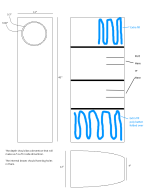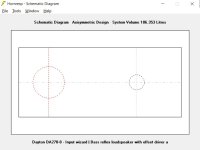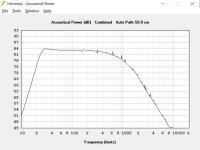I used WinISD to get the size and length of the port tube but it does not give me placement data.A simulation would solve that quickly, before you start cutting holes.
Thanks Larry. Did you use a program to determine the location? Or is it a normal location? I’m out of my depth here.5 inches up from the inside bottom.
Larry
The differences you might hear from port placement aren't always easy to explain. In theory if you can damp the higher frequencies in the box, the port frequencies are not modal and it shouldn't make a difference where you place it.
Sometimes the placement can inadvertently change the length of the port so differences might show up in an impedance plot. Sometimes the port itself has a length resonance which is excited according to position.
Sometimes the placement can inadvertently change the length of the port so differences might show up in an impedance plot. Sometimes the port itself has a length resonance which is excited according to position.
HornResp will give you precise information.
Invest some time on how it works (HornResp is free), and it will pay back itself.
Invest some time on how it works (HornResp is free), and it will pay back itself.
It is a tower so highest pressure is at the top and bottom.I have been struggling with placement of the vent pipe. I know I don’t want it on the front baffle but do I put it near the top behind the driver or down low near the floor? Any advice?
So not too low and not to high so extra fill can be used
in the upper/lower " uh-oh" zones without the fill interfering
with the port. And also making the port not too far distance
from the speakers. So longer walls don't make the theoretical length
longer. Wouldn't over think it, either in the middle of one of the braces
line the cabinet walls with absorption material and little extra in the
upper/lower pressure zones.

While hornresp is good, do you know if it does modal analysis on a regular ported box?HornResp will give you precise information.
In the direction you model it to do so, yes. 1-P modeling...plus a ringing port riding on that "carrier wave".
Why you dont put the port too high or too low.
as shown. Gives space to add extra absorption.
Pretty much what a model is gonna show you.
If the model does show you extra port barfing.
You pretty much get rid of it or tame it with
extra absorption. And dont put the port where
the cabinet would cause extra barfing.
In a long tall cabinet, that is the uh oh zone
in non technical terms. the top and bottom.
Keep the port away from it, and the stuff the krap
out of the top and bottom.
Anywhere else is just a basic lining with any old reflex.
As with towers /long walls, what a advanced model
will show you. Stuff the ends. keep port away from it
as shown. Gives space to add extra absorption.
Pretty much what a model is gonna show you.
If the model does show you extra port barfing.
You pretty much get rid of it or tame it with
extra absorption. And dont put the port where
the cabinet would cause extra barfing.
In a long tall cabinet, that is the uh oh zone
in non technical terms. the top and bottom.
Keep the port away from it, and the stuff the krap
out of the top and bottom.
Anywhere else is just a basic lining with any old reflex.
As with towers /long walls, what a advanced model
will show you. Stuff the ends. keep port away from it
Last edited:
Damping material inside the box will reduce the main Helmholz resonance, and reduce system sensitivity at bass as well.
In this regard, to get most performance out of a reflex cab one should prepare to be able to adjust port position inside the enclosure so that only modest amount of damping is enough.
If the port outputs bad (midrange) sound and one tries to dampen the resonance(s) with excessive use of damping material, also the bass sensitivity is lost. Then, why use port at all?
So, for good performance, use such port and position it so that it does not output midrange, so that modest amount of damping. Basically, position and shape of the port is very important, otherwise there is risk ruin midrange for no good reason.
In this regard, to get most performance out of a reflex cab one should prepare to be able to adjust port position inside the enclosure so that only modest amount of damping is enough.
If the port outputs bad (midrange) sound and one tries to dampen the resonance(s) with excessive use of damping material, also the bass sensitivity is lost. Then, why use port at all?
So, for good performance, use such port and position it so that it does not output midrange, so that modest amount of damping. Basically, position and shape of the port is very important, otherwise there is risk ruin midrange for no good reason.
You can use Hornresp, the "offset driver bass reflex model (OD)". It allows you to specify the driver and the port positions (3 segments, see pic). It allows you to check the tuning, port output, and combined outputs. The attached file is approximate cabinet size from your drawing, but I used a DS270, because I don't have your drivers T/S. Place the file in the Hornresp input directory, then use the import command. Lots of people here can help you drive it. Port placement has little effect on the tuning, but placing the port 30cm (12in) from the bottom gives the least "noise" on the combined output. Again, you should check the cabinet details I used and use your driver T/S details.What program do I use to simulate it?
Attachments
Hmmmmm.
Tough call.
I like to over stuff and/or lightly stuff a port and then be a bit grumpy with the less bass.......
I use Allison Kraus "A hundred miles Or more"
Some girl and guitar music.
She seems to hum while singing.....
So i add stuffing to minimize the humming.....
Tough call.....
I think a few here have doubled up on top/bottom pieces.
I think bob brines said something like once you leave the golden ratio boxes stuff, port placement is important (especially on a pipe-ish mltl).
And, I don't want to poo poo what you are doing, but I wouldn't put the driver clear up at the top of the cabinet.
Tough call.
I like to over stuff and/or lightly stuff a port and then be a bit grumpy with the less bass.......
I use Allison Kraus "A hundred miles Or more"
Some girl and guitar music.
She seems to hum while singing.....
So i add stuffing to minimize the humming.....
Tough call.....
I think a few here have doubled up on top/bottom pieces.
I think bob brines said something like once you leave the golden ratio boxes stuff, port placement is important (especially on a pipe-ish mltl).
And, I don't want to poo poo what you are doing, but I wouldn't put the driver clear up at the top of the cabinet.
Last edited:
I know the ropes of HR, but I am still learning.While hornresp is good, do you know if it does modal analysis on a regular ported box?
I would ask David McBean directly for the more technical questions. 🙂
Beautiful boxes, nice build!I have been struggling with placement of the vent pipe. I know I don’t want it on the front baffle but do I put it near the top behind the driver or down low near the floor? Any advice?
In order to minimize the risk of midrange leaking out through the port I would have put the port on the backside 5-7 inches from the bottom of the box. The reason would also be to maximize the floor boundary reinforcement of the bass.
I dont know how the crossovers for field coil drivers work but I think you will need baffle step compensation in about four to six db (which in reality means that you reduce the output above 600 - 800hz with the same nr). Since its a large full range driver you may need to stop the reduction in about 8k hz in order to augement the highest frequencies. Thereby you can experiment with toe-in of the speakers.
To reduce standing waves inside the box, I would have put some absorbing material in the bottom of the box. To reduce reflexions from the inside back wall and back through the cone (the driver looks as if its cone is made of paper) I would have put some absorbing material behind the driver.
Last edited:
if you put the inner port end near the center of the box you avoid the first box dimension resonance exiting the port, because interior enclosure dimension resonances (sometimes called "standing waves") have a velocity maximum and pressure minimum in the center. first box resonance has a wavelength of 2 x box dimension.do I put it near the top behind the driver or down low near the floor? Any advice?
you may have a look at my port (and enclosure) resonance investigation thread;
here is a measurement with the interior port end near the enclosure border (mounted towards outside in my case) and one with interior end more in the middle of the chamber:
https://www.diyaudio.com/community/...-port-resonance-absorbers.388264/post-7434497
and a post about internal helmholtz absorber:
https://www.diyaudio.com/community/...-port-resonance-absorbers.388264/post-7434471
also consider using the mass loaded quarter wave resonator model in hornresp for influence of port positioning.
I absolutely love the name of the box, by the way!
😂😂😂I'm going to guess we are not talking about the same HR. 😀
- Home
- Loudspeakers
- Full Range
- My new speakers build

